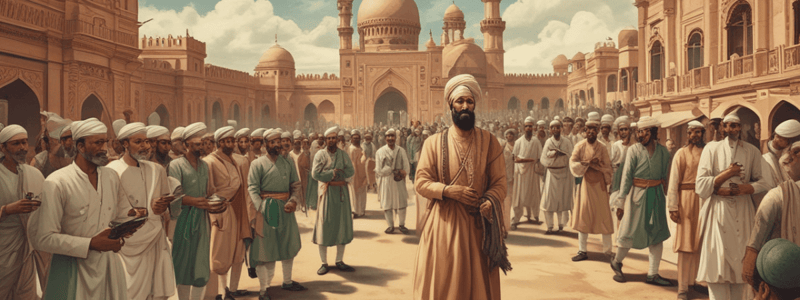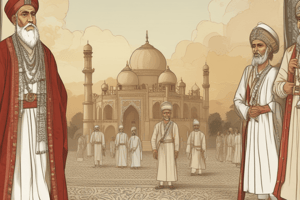Podcast
Questions and Answers
What was the main purpose of the Simla Conference organized by Lord Wavell in 1945?
What was the main purpose of the Simla Conference organized by Lord Wavell in 1945?
- To settle the issue of Pakistan's independence from British rule
- To discuss the post-war political and constitutional changes in India (correct)
- To elect a new Viceroy for India
- To negotiate a treaty between India and England
What was the claim made by Maulana Azad during the Simla Conference?
What was the claim made by Maulana Azad during the Simla Conference?
- That the Muslim League was the sole representative of Indian Muslims
- That the Congress was the sole representative of all the people living in India (correct)
- That the Viceroy's Executive Council should be expanded to include more Indian leaders
- That the British government should grant independence to India immediately
What was the main slogan of the Muslim League during the 1945-46 elections?
What was the main slogan of the Muslim League during the 1945-46 elections?
- Independence from British rule through a united India
- Self-government with the cooperation of Indian leaders
- Constitutional Assembly for framing a new constitution
- Pakistan is our ultimate goal (correct)
What was the role of students during the 1945-46 political drive?
What was the role of students during the 1945-46 political drive?
What was the basis of constitution making according to Lord Wavell's new political steps?
What was the basis of constitution making according to Lord Wavell's new political steps?
What was the Congress's stand during the 1945-46 elections?
What was the Congress's stand during the 1945-46 elections?
What was the outcome of the Central Legislature elections held in December 1945?
What was the outcome of the Central Legislature elections held in December 1945?
In which province did the ML form a ministry?
In which province did the ML form a ministry?
What was the main objective of the Cabinet Mission sent by the British Labour government in March 1946?
What was the main objective of the Cabinet Mission sent by the British Labour government in March 1946?
What was the significance of the Delhi Convention on April 19, 1946?
What was the significance of the Delhi Convention on April 19, 1946?
According to the Recommendations of the Cabinet Mission, what was the provision for communal affairs?
According to the Recommendations of the Cabinet Mission, what was the provision for communal affairs?
What was the outcome of the Interim Government formed under Nehru on September 2, 1946?
What was the outcome of the Interim Government formed under Nehru on September 2, 1946?
Who was not one of the members who joined the Interim Government on October 25, 1946?
Who was not one of the members who joined the Interim Government on October 25, 1946?
What was the main reason for the Muslim League to boycott the first session of the Constituent Assembly?
What was the main reason for the Muslim League to boycott the first session of the Constituent Assembly?
When was the Constituent Assembly elected by the provincial assemblies?
When was the Constituent Assembly elected by the provincial assemblies?
What was the outcome of the Constituent Assembly elections in 1946?
What was the outcome of the Constituent Assembly elections in 1946?
What was the Cabinet Mission Plan's proposal?
What was the Cabinet Mission Plan's proposal?
What became clear by the end of 1946?
What became clear by the end of 1946?
Flashcards are hidden until you start studying
Study Notes
Major Political Developments in 1945-46
Political Situation in 1945
- The British sought Indian military cooperation during World War II and offered political and constitutional changes after the war.
- Lord Wavell arranged the Simla Conference in June-July 1945, which was attended by representatives of all political parties, including Jinnah and Abul Kalam Azad.
- The conference failed to resolve the issue of Muslim representation, increasing differences between the Muslim League (ML) and the Congress.
The Elections, 1945-46
- Lord Wavell announced elections in August 1945 and presented new political steps, including self-government, new elections, provincial governments, and a constitutional assembly.
- The ML launched a massive campaign for Pakistan, using Islamic slogans, while the Congress focused on independence for an undivided India.
- The ML won all 30 Muslim seats in the Central Legislature elections in December 1945, while the Congress won 57 seats.
- In the provincial elections, the ML won most of the Muslim seats, including 79 out of 86 in Punjab, 113 out of 119 in Bengal, and 28 out of 35 in Sindh.
The Cabinet Mission
- The British Labour government sent a mission to formulate a constitutional settlement, which included Sir Pethick Lawrence, Stafford Cripps, and A.V.Alexander.
- The ML demanded two legislative assemblies, while anti-ML parties favored a strong center.
- The Cabinet Mission presented its recommendations in May 1946, including a federal government, a legislature and executive comprising representatives of provinces and states, and the option for provinces to review their relationship with the Union after ten years.
Muslim League and Congress Reaction
- The ML accepted the plan, considering it a step towards Pakistan, but the Congress was critical of the groupings and right to review, and refused to be bound by the proposals.
- The ML was alarmed by the Congress' intentions, which led to the formation of an Interim Government without the Congress.
Direct Action Day and Interim Government
- The ML launched a coercive political strategy, culminating in Direct Action Day on August 16, 1946, which led to the formation of the Interim Government under Nehru on September 2, 1946.
- The ML initially stayed away from the Interim Government but joined on October 25, 1946, with representatives including Liaquat Ali Khan, Sardar Abdur-Rab Nishtar, and Raja Gazanfar Ali.
Constituent Assembly
- The Constituent Assembly was elected by the provincial assemblies in July 1946, with the ML winning all Muslim seats except 5, and the Congress winning all general seats except 9.
- The ML boycotted the first session on December 9, 1946, demanding two constituent assemblies, and showed its firmness on the demand for Pakistan.
- By the end of 1946, it became clear that a constitution for united India could not be forced.
Studying That Suits You
Use AI to generate personalized quizzes and flashcards to suit your learning preferences.




